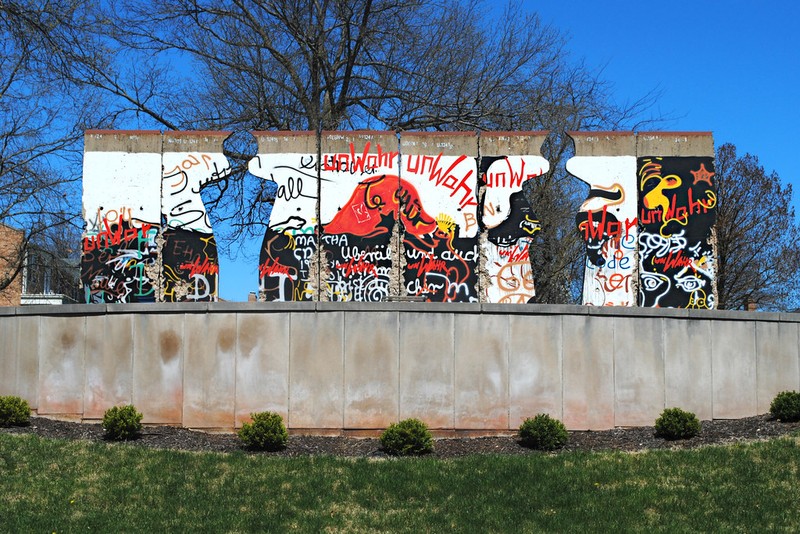Berlin Wall "Breakthrough Sculpture"
Introduction
Text-to-speech Audio
Dedicated in 1990 at the Churchill Memorial Museum at Westminster College, this sculpture was designed by Edwina Sandys, the granddaughter of Winston Churchill, using eight pieces of the Berlin Wall. Like the adjacent museum, this monument interprets aspects of the history of the Cold War in ways that incorporate the perspectives of people beyond the United States using artifacts from those nations.
Images
Berlin Wall

Section of the Breakthrough Memorial

Full Memorial

Backstory and Context
Text-to-speech Audio
East Germany began construction of the Berlin Wall on August 13, 1961. The wall was designed to prevent residents of East Germany and other areas controlled by the Soviet Union from defecting to the West. For nearly thirty years, Western leaders utilized the wall as a symbol to support their view of the Cold War in Europe. The "Breakthrough" sculpture utilizes sections of the original Berlin Wall thanks to the work of artist Edwina Sandys.
The history of this work of art is tied to the history of the Berlin Wall, a physical barrier that resulted from the division of Europe following World War II. As the war came to an end, Allied leaders met at the Yalta Conference and the Potsdam Conference determined to prevent another war. At the same time, Soviet leaders and those representing the U.S., Britain, and France sought to rebuild central Europe in their image. As a result, Germany was divided into sectors as was the city of Berlin. In June 1945 the four-way occupation of Berlin began, with the Western leaders creating West Berlin as a democratic and capitalist enclave within a communist country. Tensions escalated after many attempts to push the Western influence out of Berlin, and this led to mass emigration from East Berlin to West Berlin where economic prospects were better for skilled workers. Meanwhile, some West Berliners benefitted from government subsidies in East Berlin.
Nikita Khruschev, the leader of the Soviet Union during this part of the Cold War, approved the construction of the Berlin Wall to prohibit this emigration to the Western part of the city. In the years that followed, many lost their lives while trying to get to Western Berlin. Their struggle and the specter of a wall dividing Europe became one of the leading images of the Cold War.
This piece of art and the adjacent museum dedicated to Winston Churchill is related to one of the former British Prime Minister's most famous speeches. In 1946, Churchill arrived in Fulton where he delivered a speech that included the now-famous line warning that an "Iron Curtain" was dividing Europe between freedom in the West and communism in the East. A year after the fall of the Berlin Wall, Ronald Reagan gave a speech in front of the monument. Soviet leader Mikhail Gorbachev also gave a speech crediting the sculpture stating, “Here we stand, before a sculpture in which the sculptor’s imagination and fantasy, with remarkable expressiveness, convey the drama of the “Cold War,” the irrepressible human striving to penetrate the barriers of alienation and confrontation. It is symbolic that this artist is the granddaughter of Winston Churchill and that this sculpture should be in Fulton.”
The sculpture utilizes eight sections of the Berlin Wall, with two cutouts representing a man and a woman. The artist intends to provide a message of hope, showcasing that there is always a path forward, even when people are divided.
Sources
History.com Editors. Berlin Wall, History . December 15th 2009. Accessed November 6th 2021. https://www.history.com/topics/cold-war/berlin-wall .
Noack, Rick. Edwina Sandys’ Breakthrough in Berlin for the 25th anniversary of the Fall of the Berlin Wall, 2014, Streaming Museum . Accessed November 11th 2021. https://www.streamingmuseum.org/post/breakthrough.
America's National Churchill Museum . Berlin Wall History , National Churchill Museum . Accessed November 6th 2021. https://www.nationalchurchillmuseum.org/berlin-wall-history.html.
https://en.wikipedia.org/wiki/Berlin_Wall
https://www.waymarking.com/waymarks/wm83AC_The_Breakthrough_Fulton_Missouri
https://www.flickr.com/photos/chiski/46793146585
